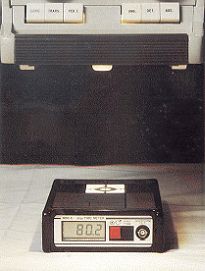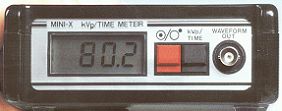


beam is attenuated through a pair of metal filter and a ratio signal proportional
to the instantaneous tube voltage is calculated.
Tube current (mA):
Tube current may be inferred by measuring mAs and dividing by the length of
exposure duration. Reasonable accuracy is achieved at longer exposure times
if the accuracy of the exposure time has been established.
Exposure time:
Many noninvasive test devices, such as the one shown above, are available for
measurement of exposure duration. Most of this devices use photodiode
detectors and base the measured time on a threshold crossing technique. These
devices may be exposure or exposure rate dependent and may not provide
good results for exposure times below 15-20 milliseconds.
(b)
X-ray tube focal spot size
Slit camera method:
A slit camera with a slit of 1 cm long and 10
m in width is used to provide
images of the focal spot on a film in both directions parallel to and
perpendicular to the anode-cathode axis.
Star phantom method:
The star phantom consists of an array of alternating highly absorbing and low
absorbing wedges. The star phantom is placed normal to and centered on to
the central axis of the X-ray beam, and a radiograph is taken. The dimension
of the focal spot can be calculated by measuring the distances of the blurring
zones in both directions parallel to and perpendicular to the cathode-anode
axis.
Setup of a kVp/Time meter